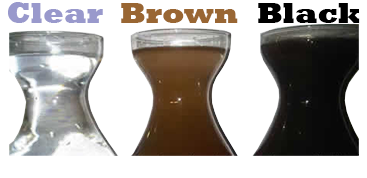What is the difference between black sludge & brown central heating sludge

Martin Smith an emergency plumber explains the difference between black & brown central heating sludge. This type of question is normally asked between plumbers that have a curiosity about what is the difference between brown central heating sludge and black sludge, when it comes to the central heating system. Thanks to my friend @APS_GAS (Twitter) also an emergency plumber Bristol, was able to get the answer. Just below are two paragraphs explaining everything you need to know about black sludge and then explaining about the brown central heating sludge.
What is Black central heating sludge made up of
Black central heating sludge, which is also known as Magnetite. Magnetite is the basic and most common type of central heating sludge found in most central heating systems to some extent filtered or not. Magnetite is the metal rust from steel equipment (radiators, central heating pump housings, cast iron heat exchanger) and is removed with a good central heating sludge remover and a central heating flushing machine. Magnetic filters are great stopping the loose particles from entering the central heating boiler, but it still needs to be loosened, which is why you can’t beat a high powered magnet fluid moving about the radiators, while the flushing machine is running.
What is Brown sludge in the central heating system made up of
Brown central heating sludge is a different type of central heating sludge, however, this can also be mixed in with black slugde at a ratio of unknown, as every system is different. Brown sludge can kill a central heating systems causing boilers to overheat. One of the problems with brown sludge is, the pipe work and radiator end up stone cold. Sometime if the brown sludge is bad enough, it may take a couple of day to de-sludge a central heating system.
Brown central heating sludge is bacterial and is mainly found in open vented systems with header tanks and can sometime end up in central heating sealed systems. Brown central heating sludge starts with an in-balance in the central heating system water. One cause is foreign bodies in the header tank. The brown sludge problem is un-common, because of the introduction of the by-law 30 kits on header tanks, however, there are still tanks fitted today with no lids on at all and debris found in them, usually organic.
The second cause of brown central heating sludge is the introduction of fresh water into the central heating system, this is quite common as an un-detected leak under a floor, which will cause the header tank ball valve to drip fresh water and the customer would never know it was happening. On most central heating systems, this can take years to turn to brown sludge and then once its in the tank, it may take many more years to get into the pipe work and then may never cause a problem other than brown water in the central heating system.
On a poorly designed system, this time scale is out the window in comparisons to the paragraph above. Once the brown central heating sludge is in the pipe work it makes resistance. On a poorly design central heating system, the first sign is the head expansion pipe pumping over, central heating water starts dripping from the expansion pipe, which the water is hot, the hot water seems to get brown sludge going, the how water changes the brown sludge and a white crust forms on the sludge where it meets the air. The brown central heating sludge below the water thickens up, as it thickens, it created more resistance in the pipe work and the expansion pipe starts to run hot water. Once the expansion pipe starts running hot water, the sludgy water is drawn into the central heating system to replace the water that’s running out of the expansion pipe, this action makes the brown central heating sludge worse and worse. The more and quicker the expansion pipe runs, the more sludge it seems to create. In time, your central heating header tank is full of hot brown sludge, this is also being circulated around the central heating system, also the leak from the float operating valve (Ballcock) is still leaking, so now you have a dripping ball valve, adding limescale and other chemicals into you hot brown central heating sludge, which now is so thick that the expansion pipe is now running full bore and at this point you only have weeks left.
Once you have weeks left until the central heating system stops working due to the brown sludge the sludge will getting thicker each time it passes through the tank. Now the sludge starts to dry on the internal surface of the pipe work and it then starts to lining the pipes and central heating radiators, which creates more resistance and pushes the sludge through the tank faster. The process is repeated, eventually the whole system just stops and the brown central heating sludge becomes solid. Brown central heating sludge at it’s worst can end up with the replacement of the central heating system.
We have a similar article called 19 central heating sludge problems & cures. If you suffer from any of the central heating problems due to brown or black central heating sludge and your looking for an emergency plumber, then please give us a call on the above contact number and we will recommend you a central heating plumbing engineer. If your an emergency plumber that also specialises in removing brown or black central heating sludge, then please visit our plumbing register.

